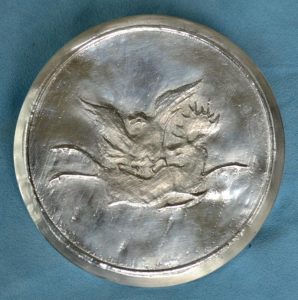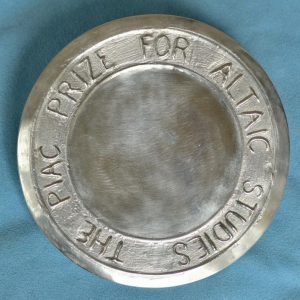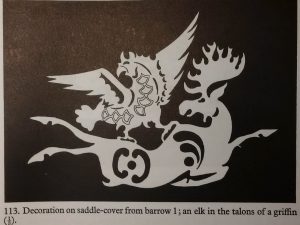In continuation of the fine tradition of the Indiana University Prize for Altaic Studies inaugurated in 1962, a new medal was created in 2017 which is officially supported and funded by the PIAC members: The PIAC Prize For Altaic Studies. The resolution to this effect was passed during the 60th Annual Meeting of the PIAC in Székesfehérvár, 2017:
The members assembled in the 60th Meeting of the PIAC appreciate that Indiana University, by means of endowing the Indiana Prize for Altaic Studies and the Medal associated with, colloquially going by the name of “PIAC Medal”, during a half a century, from 1963 to 2014, has given unique recognition of and fundamental support to the cause of Altaic Studies in a worldwide scale. The Indiana University Prize for Altaic Studies has been awarded to the most distinguished scholars in the field.
The members assembled in the 60th meeting are convinced that a PIAC prize is indeed a central foundation to further the cause of Altaic Studies, and thus decide to continue the fine tradition of awarding a PIAC prize anew, collectively supported by the members of the PIAC. Since this new PIAC prize will from now on be awarded by the members of the PIAC, the new prize will be baptized “The PIAC Prize for Altaic Studies”. The procedure for electing the recipient of the Prize will respect the time-honoured tradition of establishing a yearly Medal Committee and resume this procedure unchanged.
The new medal was sculpted by a young German sculptor, Frank Förster. It features an artistic rendering of the PIAC logo on the obverse and the words THE PIAC PRIZE FOR ALTAIC STUDIES on the reverse. The now familiar PIAC logo was first used in 1987 (PIAC Newsletter No. 17) and replaced the variety of abstract symbols composed of a stylized globe and the letters PIAC which appeared on earlier programs, proceedings etc. The logo reflects the design of a leather application found in barrow #1 of the famous Pazyryk burial site. Sergej Rudenko (Rudenko, Sergej Ivanovič: Frozen Tombs of Siberia. The Pazyryk burials of iron age horsemen. University of California Press, Berkeley 1970, p. 231) writes:
A unique composition in leather cut-out from barrow 1 is that of an elk in the talons of a big-eared griffin (fig. 113). The heavy-muzzled head of the elk with large ears and typical palmating antlers is a particularly lively piece of work, and the whole group has been dealt with in a masterly way, simply and yet comprehensively. The strong body has a twisted crupper, slender legs and short tail, and the trunk is slashed with stops, command and half-horseshoes. The griffin, with big ears and a comb, extended wings and a distended tail, grips the elk in its claws. The piece was pasted to a red saddle-cloth and pasted covered with tinfoil.
The object is on public display in the Ermitage Museum at the Winter Palace, 1st Level, Room 28, Room of the Culture and Art of the Nomadic Tribes of the Altai in the 5th to 3th century B.C.
A copy of this medal is cast in sterling silver every year the prize is awarded, the name of the recipient being engraved on the reverse. With a diameter of approximately 94 mm or 3.7 inches, its mass is approximately 200 gr.
 |
 |
| The PIAC Prize For Altaic Studies Medal — obverse | The PIAC Prize For Altaic Studies — reverse |
The PIAC Prize for Altaic Studies is fully financed by those PIAC members who participate in a given year.
Since is conception, the PIAC Prize for Altaic Studies has been awarded to:
2018 Dieter Maue (Germany)
2019 Martin Gimm (Germany)
2020 (63rd Meeting postponed to 2021)
2021 (not awarded)
2022 Sárközi, Alice (Hungary)
2023 Barbara Kellner-Heinkele (Germany)
2024 (not awarded)

